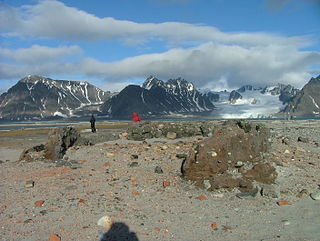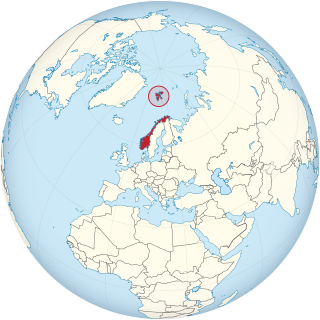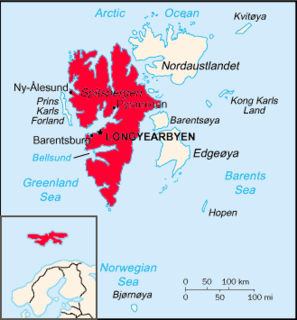 W
WThe 2011 Svalbard polar bear attack was an attack by a starving polar bear on a group of university students and their guides. The bear killed one person, injured four others, and was then shot.
 W
WAndrée's Arctic balloon expedition of 1897 was an effort to reach the North Pole in which all three Swedish expedition members – S. A. Andrée, Knut Frænkel, and Nils Strindberg – perished. Andrée, the first Swedish balloonist, proposed a voyage by hydrogen balloon from Svalbard to either Russia or Canada, which was to pass, with luck, straight over the North Pole on the way. The scheme was received with patriotic enthusiasm in Sweden, a northern nation that had fallen behind in the race for the North Pole.
 W
WThe archaeology of Svalbard is the study of human activity in the northerly Arctic Ocean archipelago's past. The geography, environment and climate of Svalbard have resulted in exceptional preservation conditions. Archaeological fieldwork on Svalbard is both expensive and physically exhausting, but new technology and infrastructure has allowed easier access. This easier access has also resulted in more damage caused by tourists.
 W
WThe 1954 Bjørnøya Consolidated PBY Catalina crash was a controlled flight into terrain (CFIT) of a Consolidated PBY Catalina on the island of Bjørnøya in Svalbard, Norway, on 28 March 1954 at ca. 15:00. The Royal Norwegian Air Force aircraft of No. 333 Squadron RNoAF was conducting a postal drop flight from Tromsø to five settlements on Svalbard, including Bjørnøya Radio, making a low pass over Bjørnøya at a height of 40 meters (130 ft) before crashing into the ground. Only one of the nine on board survived.
 W
WThe Bratvaag Expedition was a Norwegian expedition in 1930 led by Dr. Gunnar Horn, whose official tasks were hunting seals and to study glaciers and seas in the Svalbard Arctic region. The name of the expedition was taken from its ship, M/S Bratvaag of Ålesund, in which captain Peder Eliassen had sailed the Arctic seas for more than twenty years. The Bratvaag Expedition had a secret, but important mission: the annexation of Victoria Island for Norway. Although a successful landing on the island was achieved, Victoria Island was later annexed by the Soviet Union. The Bratvaag Expedition became nevertheless well-known due to the findings on Kvitøya of the long-lost remains of the Swedish explorer S. A. Andrée's Arctic balloon expedition of 1897.
 W
WThis article covers the science, art and industry of cartography by the people of the Low Countries in the early modern period, especially in the early 16th to early 18th centuries. It includes cartography of the Northern Netherlands, Southern Netherlands and Low Countries in general. It also includes Dutch colonial cartography, i.e. cartography in the Dutch overseas world, in the early modern period.
 W
WOperation Fritham was an Allied military operation during the Second World War to secure the coal mines on Spitsbergen, the main island of the Svalbard Archipelago, 650 mi (1,050 km) from the North Pole and about the same distance from Norway. The operation was intended to deny the islands to Nazi Germany.
 W
WOperation Gauntlet was an Allied Combined Operation from 25 August until 3 September 1941, during the Second World War. Canadian, British and Free Norwegian Forces landed on the Norwegian island of Spitsbergen in the Svalbard Archipelago, 650 mi (1,050 km) south of the North Pole.
 W
WOperation Gearbox was a Norwegian and British operation on the Arctic island of Spitzbergen in the Svalbard Archipelago, during the Second World War. Operation Fritham, an earlier expedition in two ships, arrived on 13 May but met disaster after being spotted by a Luftwaffe Ju 88 bomber. Next day, four Fw 200 reconnaissance bombers attacked and killed fourteen men, including Einar Sverdrup, the commander. Eleven men were wounded, two mortally, one ship was sunk and the other set on fire.
 W
WOperation Gearbox II was a Norwegian and British operation during the Second World War on the Arctic island of Spitzbergen in the Svalbard Archipelago. Operation Fritham, the first attempt to establish a base had been defeated when the two ships carrying the force were sunk by Luftwaffe bombers on 14 May.
 W
WNy-Ålesund was first discovered in 1610, when coal deposits were discovered around Kongsfjorden. Not until the 1860s were they investigated more carefully. Ålesund-based Peter Brandal bought the claims in 1916 and established the company Kings Bay. The town, originally known as Brandal City and Kings Bay, was founded that summer when coal mining commenced. The first research installation, a geophysical station at Kvadehuken, was established in 1920. The mining was soon unprofitable and was kept running through state subsidies. In the mid-1920s the town was used for a series of airship expeditions towards the North Pole.
 W
WOperation Haudegen was the name of a German operation during the Second World War to establish meteorological stations on Svalbard. In September 1944, the submarine U-307 and the supply ship Carl J. Busch transported the men of Unternehmen Haudegen to the island. The station was active from 9 September 1944 to 4 September 1945 but lost radio contact in May 1945. The soldiers were capable of asking for support only in August 1945 and on 4 September, were picked up by a Norwegian seal hunting vessel and surrendered to its captain. The group of men were the last German troops to surrender after the Second World War.
 W
WThe Svalbard Treaty recognises the sovereignty of Norway over the Arctic archipelago of Svalbard, at the time called Spitsbergen. The exercise of sovereignty is, however, subject to certain stipulations, and not all Norwegian law applies. The treaty regulates the demilitarisation of the archipelago. The signatories were given equal rights to engage in commercial activities on the islands. As of 2012, Norway and Russia are making use of this right.
 W
WThe Svenskhuset Tragedy was an event in the winter of 1872–73 where seventeen men died in an isolated house on Spitsbergen, Svalbard. The cause of death was long believed to be scurvy, but research done in 2008 has revealed that the men probably suffered lead poisoning. Svenskehuset is today preserved as a cultural heritage site.
 W
WVnukovo Airlines Flight 2801 was an international charter flight from Vnukovo International Airport in Moscow, Russia to Svalbard Airport in Longyearbyen, Svalbard Norway. On 29 August 1996, at 10:22:23 Central European Summer Time, a Tupolev Tu-154M operating this flight crashed in Operafjellet, Svalbard, during the approach to Svalbard Airport, Longyear. All 141 people aboard the plane were killed, making it the deadliest aviation accident ever in Norway. The accident was the result of a series of small navigational errors causing the aircraft to be 3.7 kilometres from the approach centerline at the time of impact.
 W
WOperation Zitronella, also known as Unternehmen Sizilien (Sicily), was an eight-hour German raid on Spitzbergen, in the Svalbard Archipelago, on 8 September 1943. The battleships Tirpitz and Scharnhorst, plus nine destroyers, sailed to the archipelago, bombarded settlements in Isfjorden and covered a landing party. Six Norwegians were killed and 31 were taken prisoner; one German died of wounds and fifteen were wounded.